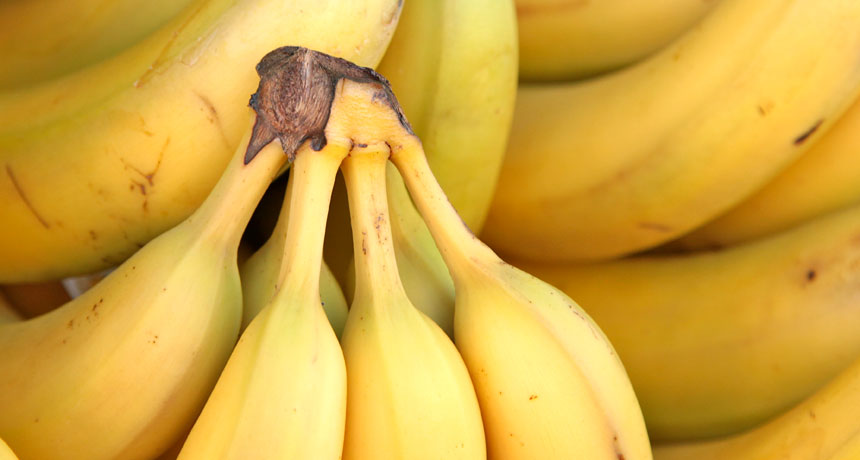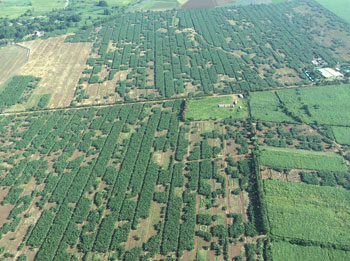Banana threat: Attack of the clones
Scientists find that many of the fungi killing bananas around the world are clones of one another

These Cavendish bananas are the “dessert” variety found in grocery stores across North America and Europe. But millions of people around the world also eat many less sweet bananas.
torbakhopper/Flickr/(CC BY 2.0)
The fight to save the banana just got more challenging. A fungus that threatens the world’s most popular fruit is spreading, according to a new study. And it’s doing so despite massive efforts to stop it.
At risk is the sweet “Cavendish” banana sold in North America and Europe. But that’s not all. There are 400 edible varieties of banana, and many of them also are susceptible to killing by Panama disease. (That’s the name of the disease that this fungus causes.) Indeed, many of those other types of bananas are important sources of food for millions of people outside the United States and Europe.
The killer fungus is known as Tropical Race 4, or TR4 for short. It’s the fourth type of fungus to cause Panama disease that scientists have identified. It spreads slowly but easily, wiping out banana crops wherever it goes.
To date, TR4 has shown up in China, Indonesia, Malaysia and Australia. It’s reached the Philippines and southern Africa. And it has been discovered in the Middle East and Asian countries of Jordan, Lebanon and Pakistan.
For their new study, Gert Kema and his team examined fungi from each of these locations. Kema is a plant pathologist at Wageningen University and Research Centre in the Netherlands. (A pathologist studies disease.) The researchers wanted to identify strains of TR4 infecting the plants. So they analyzed TR4 DNA from bananas in those countries.

If the genes in some bananas were quite different from those in others of their type, some plants might be able to resist the fungi. Unfortunately, Cavendish bananas lack any diversity. That’s because they too are all clones.
The new findings were published November 19 in PLOS Pathogens.
Fungal stalker can lay in wait a very long time
For years, scientists have been scouting for TR4 wherever bananas are grown. But this pathogen is almost impossible to see coming. That’s because it attacks from the soil. After invading a plant’s roots, the fungus grows long hyphae (HY-fee). These thread-like filaments worm their way into the plant’s vascular system. This system of tubes carries water and nutrients up from the soil and into plant leaves. The plant responds to the invasion by blocking off the tubes. Over time, less and less water can reach the leaves, and the plant starts to wilt.
No cure for plants infected with TR4 exists. All invariably die. Meanwhile, the fungus releases spores into the soil. These tough, seed-like structures lie in wait until another banana is planted nearby. Then they attack it. That means a farm or plantation that has been infected will stay infected. And live spores can hang on in the soil for decades, waiting for their next victim.
What’s more, irrigation water and equipment can spread the disease. If machetes and other tools are not properly cleaned after being used, they can carry bits of fungus from infected plants to healthy ones. Even dirt on the soles of shoes can track spores from one spot to another. All of this helps to explain how TR4 has been spreading since its original outbreak in Taiwan.
Because Cavendish bananas lack seeds, growers at some large plantations generate new plants from suckers, or the offshoots of adult plants. Another way is to expose clumps of cells to a nutrient bath. These clumps grow into new plants that are genetically identical to their parents. It’s an efficient way to grow thousands of plants. But as clones, every single plant is as vulnerable as all its neighbor to the same disease-causing organisms, Kema says. Worse, all of these clones are planted together, covering hundreds of hectares (thousands of acres). Such monocultures are extremely vulnerable to disease, Kema notes. Once one plant is infected, the disease rapidly spreads through the entire crop.
His team identified the TR4 clones through a DNA-sequencing technique. It allows rapid identification of an organism’s genes. Traditional methods are much slower, Kema says. Farmers also can use a different type of DNA test to check their soil, he notes. This would allow them to detect the pathogen before their plants show symptoms. Doing so could help to slow the spread of TR4, he says. The hope is that over time researchers may be able to develop bananas that are resistant to the fungus.
Altus Viljoen isn’t sure the new method is the best way to monitor for TR4. This TR4 expert works at Stellenbosch University in South Africa and was not involved with the new study. The DNA-sequencing method Kema’s group used simply isn’t available in many areas, he says. Regardless, Viljoen agrees that the absence of genetic diversity in bananas and in TR4 is a concern. It means that clones grown as a monoculture can be “severely damaged by diseases and pests,” he says. If one plant is vulnerable to the fungus, every other one will be too.
It’s a race against the clock for banana growers and scientists. And it will take a world-wide effort to stop the steady march of TR4 and save the banana.
Power Words
(for more about Power Words, click here)
clone An organism that has exactly the same genes as another, like identical twins. Often a clone, particularly among plants, has been created using the cell of an existing organism.
DNA (short for deoxyribonucleic acid) A long, double-stranded and spiral-shaped molecule inside most living cells that carries genetic instructions. In all living things, from plants and animals to microbes, these instructions tell cells which molecules to make.
DNA sequencing The process of determining the exact order of the paired building blocks — called nucleotides — that form each rung of a ladder-like strand of DNA. There are only four nucleotides: adenine, cytosine, guanine and thymine (which are abbreviated A, C, G and T). And adenine always pairs up with thymine; cytosine always pairs with guanine.
fungus (plural: fungi) One of a group of single- or multiple-celled organisms that reproduce via spores and feed on living or decaying organic matter. Examples include mold, yeasts and mushrooms.
gene (adj. genetic) A segment of DNA that codes, or holds instructions, for producing a protein. Offspring inherit genes from their parents. Genes influence how an organism looks and behaves.
genetic diversity The range of genes types — and traits — within a population of some organism.
hypha (plural: hyphae) A tubular, threadlike structure that makes up part of many fungi.
infection A disease that can spread from one organism to another.
monoculture Large areas planted with a single type of crop.
pathogen An organism that causes disease.
pathology The study of diseases and/or conditions that lead to death. People who work in this field are called pathologists. They look at what causes a disease, how symptoms develop and may examine all stages of an illness.
spore A tiny, typically single-celled body that is formed by certain bacteria in response to bad conditions. Or it can be the single-celled reproductive stage of a fungus (functioning much like a seed) that is released and spread by wind or water. Most are protected against drying out or heat and can remain viable for long periods, until conditions are right for their growth.
strain (in biology) Organisms that belong to the same species that share some small but definable characteristics. For example, biologists breed certain strains of mice that may have a particular susceptibility to disease. Certain bacteria or viruses may develop one or more mutations that turn them into a strain that is immune to the ordinarily lethal effect of one or more drugs.
sucker A shoot from the base of a plant.
Tropical Race 4 (TR4) The fourth identified strain of the fungus that causes Panama disease. TR4 is the deadliest strain, currently threatening nearly 85 percent of the world’s bananas.
tropics The region near Earth’s equator. Temperatures here are generally warm to hot, year-round.
vascular system A system of plant tissues and fibers that carries water and nutrients from the soil up into the leaves, and food from the leaves to other parts of the plant.







